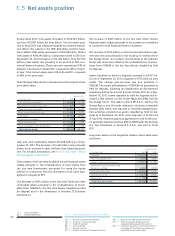Siemens 2011 Annual Report Download - page 224
Download and view the complete annual report
Please find page 224 of the 2011 Siemens annual report below. You can navigate through the pages in the report by either clicking on the pages listed below, or by using the keyword search tool below to find specific information within the annual report.
6 A. To our shareholders
23 B. Corporate Governance 51 C. Combined management’s discussion and analysis
52 C. Business and operating environment
80 C. Fiscal – Financial summary
83 C. Results of operations
101 C. Financial position
114 C. Net assets position
117 C. Overall assessment of the economic position
118 C. Report on post-balance sheet date events
119 C. Report on expected developments and
associated material opportunities and risks
135 C. Information required pursuant to Section ()
and Section () of the German Commercial
Code (HGB) and explanatory report
C.. Risk management
Our risk management policy stems from a philosophy of pur-
suing sustainable growth and creating economic value while
avoiding and managing inappropriate risks. As risk manage-
ment is an integral part of how we plan and execute our busi-
ness strategies, our risk management policy is set by the Man-
aging Board. Our organizational and accountability structure
requires each of the respective managements of our Sectors,
SFS, SRE, regional Clusters and Corporate Units to implement
risk management programs that are tailored to their specific
industries and responsibilities, while being consistent with
the overall policy established by the Managing Board.
We have implemented and coordinated a set of risk manage-
ment and control systems which support us in the early rec-
ognition of developments jeopardizing the continuity of our
business. The most important of these systems include our
enterprise-wide processes for strategic planning and manage-
ment reporting. Strategic planning is intended to support us
in considering potential risks well in advance of major busi-
ness decisions, while management reporting is intended to
enable us to monitor such risks more closely as our business
progresses. Our internal auditors regularly review the adequa-
cy and effectiveness of our risk management system. Accord-
ingly, if deficits are detected, it is possible to adopt appropri-
ate measures for their elimination. This coordination of pro-
cesses and procedures is intended to help ensure that the
Managing Board and the Supervisory Board are fully informed
about significant risks in a timely manner.
Risk management at Siemens is based on a comprehensive,
interactive and management-oriented Enterprise Risk Man-
agement (ERM) approach that is integrated into the organiza-
tion and that addresses both risks and opportunities. Our ERM
approach is based on the worldwide accepted “Enterprise Risk
Management – Integrated Framework” developed by the “Com-
mittee
of Sponsoring Organizations of the Treadway Commis-
sion” (COSO). The framework connects the ERM process with
our financial reporting process and is closely integrated in our
internal control system. It considers a company ’s strategy, the
efficiency and effectiveness of its business operations, the re-
liability of its financial reporting as well as compliance with
relevant laws and regulations to be equally important.
The ERM process aims for early identification and evaluation
of, and response regarding risks and opportunities that could
materially affect the achievement of our strategic, operation-
al, financial and compliance objectives. Our ERM is based on a
net risk approach, covering risks and opportunities remaining
after the execution of existing control measures. In order to
provide a comprehensive view on our business activities, risks
and opportunities are identified in a structured way combin-
ing elements of a top-down and bottom-up approach. Risks
and opportunities are generally reported on a quarterly basis.
This regular reporting process is complemented by an ad-hoc
reporting process that aims to escalate critical issues in a
timely manner. Relevant risks and opportunities are priori-
tized in terms of impact and likelihood, considering quantita-
tive and / or qualitative perspectives. The bottom-up identifica-
tion and prioritization process is supported by workshops
with the respective management of the Sector, SFS, SRE, re-
gional Cluster and Corporate Unit organizations. This top-
down element ensures that potential new risks and opportu-
nities are discussed at the management level and are includ-
ed in the subsequent reporting process, if found to be rele-
vant. Reported risks and opportunities are analyzed regarding
potential cumulative effects and are aggregated at Sector,
SFS, SRE, regional Cluster and corporate level.
Responsibilities are assigned for all relevant risks and oppor-
tunities with the hierarchical level of responsibility depending
on the significance of the respective risk or opportunity. In a
first step, assuming responsibility for a specific risk or oppor-
tunity involves deciding upon one of our general response
strategies, or a combination of them. Our general response
strategies with respect to risks are avoidance, transfer, reduc-
tion or acceptance of the relevant risk. Our general response
strategies with respect to opportunities are non-realization,
transfer and partial or complete realization of the relevant op-
portunity. In a second step, responsibility for a risk or oppor-
tunity also involves the development, initiation and monitor-
ing of appropriate response measures corresponding to the
chosen response strategy. These response measures have to
be specifically tailored to allow for effective risk management.
Accordingly, we have developed a variety of response mea-
sures with different characteristics: For example, we mitigate
the risk of fluctuations in currency and interest rates by en-
gaging in hedging activities. Regarding our long-term proj-
ects, systematic and comprehensive project management
with standardized project milestones, including provisional
acceptances during project execution, and complemented by
clearly defined approval processes assists us in identifying
and responding to project risks at an early stage, even before
entering the bidding phase. Furthermore, we maintain appro-
priate insurance levels for potential cases of damage and lia-
























